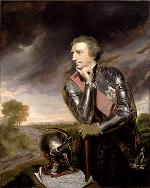British General Jeffery Amherst
Jeffery Amherst was commander of the British Army during the French and Indian War and the architect of the iconic seizure of the thought-to-be-impregnable French fortress of Louisbourg in 1758. He was born on Jan. 29, 1717, in Riverhead, Kent County, England. Not much is known of his early life before he joined the army, in 1735. An astute soldier, Amherst rose rapidly through ranks and served as an aide-de-camp to General John Ligonier in the War of the Austrian Succession, fighting in a few battles. He was part of the British force that went home in 1745 to repel the Jacobite Rebellion, one of a handful of attempts by the Stuart family to regain the English throne. When the Treaty of Aix-la-Chappelle ended the War of the Austrian Succession in 1748, Amherst stayed on in the army. 
Amherst fought briefly in the Seven Years' War, in Europe, but gained his fame in North America, commanding forces during the French and Indian War. In 1758, he accepted an appointment to command British forces targeting the daunting French stronghold of Louisbourg. British troops led by admiral Edward Boscawen sailed from Halifax, Nova Scotia, under cover of darkness to Cape Breton Island, then had to wait almost a week for heavy fog to lift before attacking. The French defense was sturdy, but British luck won out once again as a small band of sailors managed to land onshore and secure a beachhead while a lucky shot from a British ship touched off a French gunpowder store, igniting most of the other French ships in a tremendous fireball. Once the British were onshore, it was only a matter of time. The battle turned into a siege, and the French finally surrendered, more than three weeks after the fighting began. This battle was extremely important in that it effectively cut off French reinforcements. It also allowed allowed the British to sail down the St. Lawrence River to Quebec, the last real French stronghold in North America. After that success, Amherst gained the command of British forces in North America, a post he would hold for the remainder of the war. At his direction, contingents of the British Army seized the strategically important forts of Niagara and Ticonderoga and then, in 1760, took control of Montreal, effectively engineering the end of New France, what is now Canada. The Treaty of Paris that ended the war came in 1763, but the bulk of the fighting was done a few years before. He proved unable to contain a Native American uprising known as Pontiac's Rebellion, however, and was recalled to England. Also at this time spread the story that Amherst was in favor of or actually had carried out a strategy of giving Native Americans blankets infected with smallpox, for which they would have had no immunity. The deadly disease did spread at this time, particularly in what is now western Pennsylvania; as well, a letter can still be found in which Amherst discusses the possibility. Definitive proof that such a thing occurred is lacking, however. 
Amherst was named governor of the Virginia colony in 1759. He served in that capacity for nearly a decade but never visited the colony. When the British Government decided that the colonial governor should actually live in the colony, Amherst refused and was removed from the position. He resigned from the army in protest but soon requested reinstatement. His next governorship was of Guernsey. In 1778, he achieved the rank of full general and was named command of all British forces in England. Despite this status, he did not travel to North America and so did not fight in the Revolutionary War and also did not fight in the initial stages of the Napoleonic Wars. He did command British troops in putting down the Gordon Riots, in June 1780. He had married twice, in 1753 to Jane Dalyson (who died a decade later) and in 1767 to Elizabeth Cary. He had no children. He was knighted in 1761 and built a new home, which he called Montreal. He died on Aug. 3, 1797. A town and college in Massachusetts are named after him, as are many places and streets in both the U.S. and Canada. |
|




